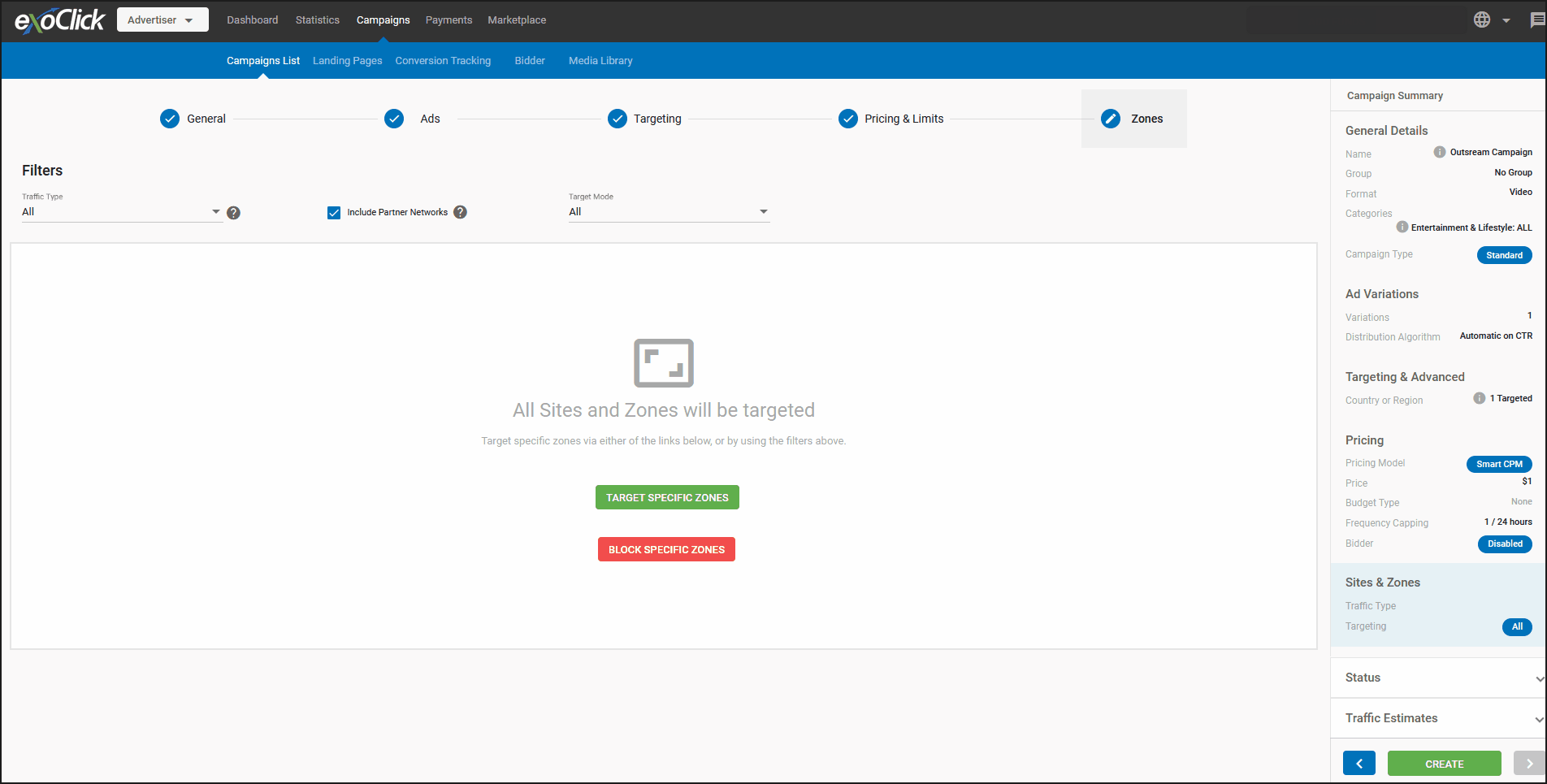Advertiser Guide to using Outstream Video
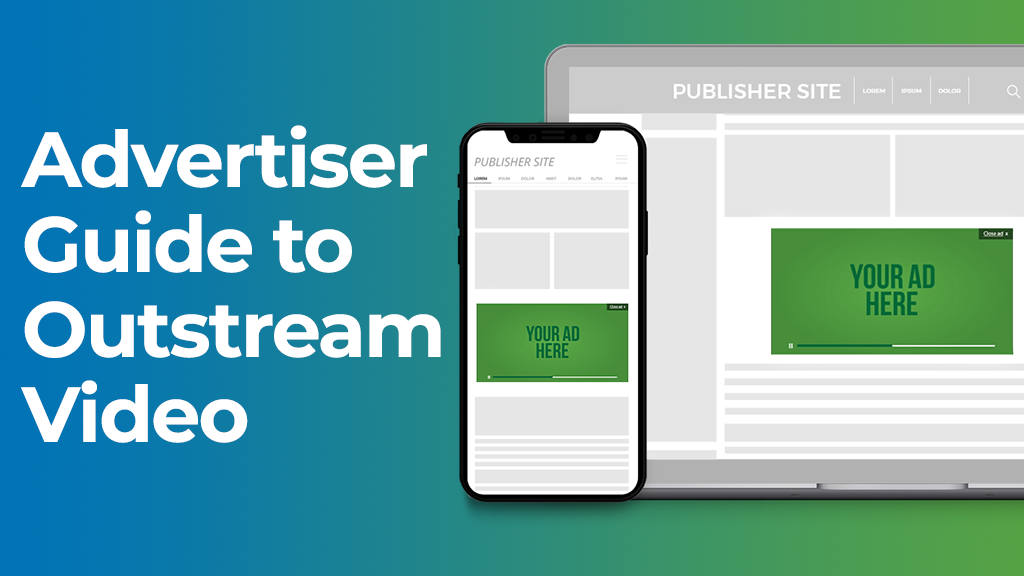
According to HubSpot, 52% of marketers say video is the type of content with the best ROI. A Singlegrain report noted that 93% of marketers use video. This is because viewers claim they retain 95% of a message when obtained via video (Social Media Week) and Wyzolw states 84% of people say that they’ve been convinced to buy a product or service by watching a brand’s video.
With the explosion of TikTok, Reels and the dominance of video traffic online the whole world is embracing video. Video ads have a much higher CTR bringing big potential for sales. Welcome our new video format Outstream!
This guide will explain:
- How is Outstream displayed?
- Outstream benefits to Advertisers
- Outstream best practices
- Outstream campaign creation
How is Outstream displayed?
The Outstream Video ad is shown to the end user during their user journey and is fully responsive, playing on desktop, tablet and mobile.
Publishers set the positioning on their website for when the video ad will trigger. As the user scrolls down the page the ad zone pushes the website’s content down and the Outstream ad starts being visible to the user. This is really eye catching to the end user.
Once 50% of the Outstream ad zone is viewable on screen, the video ad automatically plays on mute, the end user can unmute the video ad. Clicking or tapping the video ad opens your offer’s landing page in a new tab.
As the end user scrolls further down the webpage the video ad will pause, waiting to resume playing when the end user comes back to the content where the Outstream ad is located.
Benefits to Advertisers
- It’s great value. With a choice of CPM, CPC and CPV you can test which bidding format works the best for you. With CPM you pay only for viewable impressions, when the video ad starts playing on the users screen, while with CPV you only pay for video views of 10 seconds and over.
- Because the Outstream video ad format is part of the user journey on a website it gets a much higher view ration. According to eMarketer 77% of agencies and 70% of advertisers prefer Outstream ads.
- Higher CTR, the click rate is higher compared to standard display ads.
- Easy and transparent setup. Video campaigns will automatically run on this new ad zone if you select all video ad types in your admin panel, or you can create specific Outstream video campaigns.
- Deep Targeting. All targeting options are available for advertisers. Additionally you can use keyword targeting to reach users who are interested in a particular niche that is related to your offer.
Best practices for Advertisers
Create Outstream specific campaigns:In your admin panel when selecting the Video ad format, you will see All video ad formats are highlighted, including RTB Supply.

You should only highlight the video format you want your campaign to run on, in this case only select the Outstream Video Tab by clicking on it, otherwise your campaign will run across all video formats. Regarding the RTB tabs, unless you are experiecned in buying RTB Supply, we recommend that you do not highlight the Outstream RTB Video Supply Tab.

Create Device specific campaigns. Key metrics such as View ration, CTR, eCPC and of course eCPM vary a lot between Mobile and Desktop devices.
Video creative: We recommend that your video ads are of a decent quality, shooting using a mobile phone for live footage is perfectly acceptable these days, and can help your offer appeal to a younger TikTok audience.
On Mute: Remember that Oustream video always plays on mute until the viewer clicks to un mute it, so ensure that you always include subtitles in the language that you are targeting. In fact you could get away with having no voiceover at all on the video ad, it could just be music if the user unmutes, but you are still telling the user about your offer using texts.
Unmute: If you want to include a voiceover in your Outstream video ad, you could use texts in the video ad to prompt the user to unmute the video, tell them they are missing out on something important so they should unmute for more details.
Beat the scroller: To stop the end user scrolling away from your Outstream video ad use a completing text or graphics that spark their interest as soon as the video has reached a 50% viewability.
Getting clicks/a higher viewability: Because of it’s placement your Outstream Video ad becomes part of the user journey, so that the user pauses, rather than continuing scrolling. Because of the mute button your texts will have to work harder to capture the user’s attention, but don’t worry here are some text tips you can try with your campaigns:
- Make it a question: Get them thinking by starting your text with phrases such as Did you know…? How can you find…?” “What’s the best…?” “Have you ever tried…?” “Are you…?
- Use facts and statistics: People love facts not fake news e.g. 80% of men… , 9 out of 10 cats… , etc
- Use numbers: Numbers are easier for a reader to notice for example: ‘7 things you should know about shampoo’ works better than ‘Seven things…’ plus it saves you character space!
- News worthy: Exploit big current news stories or big movie/Netflix series releases so you can tie your texts into this.
- Offer a lifehack: People love to learn new things to make their lives easier or to learn new tricks e.g. ‘How to get the girlfriend of your dreams’ ‘How to save 3 hours a day’
- Be negative: Sometimes negative words such as ‘worst’ gain more clicks than positive ones like ‘best.’ Negative statements are intriguing and seem more authentic and genuine e.g. ‘Your worst nightmare just came true, but this will fix it.’
- Translations: Chances are that you will be targeting different countries so make sure that you use a native speaker to translate your texts and concepts, never use Google Translate, it will make your Native ad less clickable.
Creative specs: Outstream video is fully responsive so only these standard video specs appy:
- Type: MPEG-4 video (video/mp4)
- Video Codec: H.264
- Audio Codec MPEG-4 AAC
- Please note we are aligned with the IAB standards video file weight is limited to 50MB.
Reuse your In-stream ad campaigns: You can use the same ad creative you used for your In-stream campaigns.
Test out your In-stream ad zones: So if you target the same sites that you bid on for In-stream ad zones, you will reach the websites whole audience and not just the ones watching an in-stream video on a particular ad zone. Using Outstream will ensure that even users on the site not necessarily watching video content, will see your video ad.
Keyword targeting: Some publishers have keyword targeting tagged for different web pages devoted to certain categories to attract advertisers with specific products or video creatives related to the web pages content. For example, if you have a dating offer use keyword targeting such as: love, dating, romance, etc. That way your Outstream dating ad will be contextually relevant to the end user and generate more clicks.
Blend in: If you are targeting flat traffic deal for one particular big volume traffic site you could adapt your Outstream ad to copy the style of content on the site using the same font, font colour and size, so, as with Native ads it appears more like the content of the publisher’s website to generate more clicks.
Use VAST: VAST Wrappers are common in the video ad serving industry. One of the benefits of using a VAST wrapper is that it allows a third party to insert their own tracking events and receive notification of when certain events occur (for example, when the video starts to play, video completion, clicks, etc).
VAST allows you to use Custom Attribution: What if a user saw your video ad and didn’t click on it, but later remembered your product and did a type in search in Google – wouldn’t it be good to know that this type in came because he had previously seen your video? What if a user saw your video but didn’t click but later saw your banner ad for the same offer then clicked on the banner – wouldn’t it be useful for you to know that he had previously also watched your video. This called Custom Attribution for deeper tracking
Campaign Creation
Step 1: First, go to the “Campaigns” tab and click “New Campaign”

Step 2: General
- Enter the name for the ad campaign and set the Video format in the ad selector.
- You can also add the campaign to a group and create groups to add it to.
- The Outstream Video zone type will appear along with the other zone types, Video Slider, In-Stream Video (VAST)
- The ad will run on ALL zone types by default, but you can choose what zone types to include or exclude using the selection buttons.
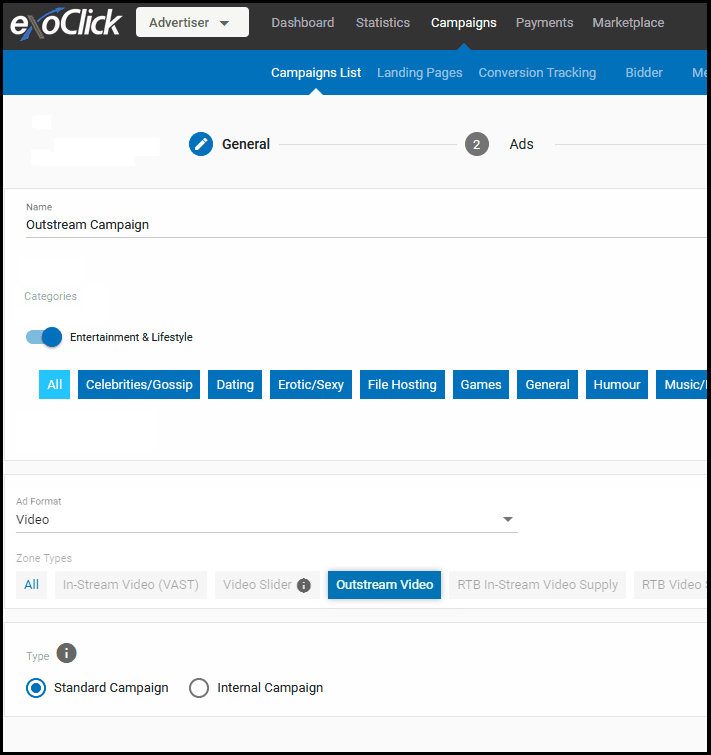
Step 3: Ads – Create the ad variations for the campaign and select a Distribution Algorithm to distribute traffic between them. Below is Step 3’s flow:
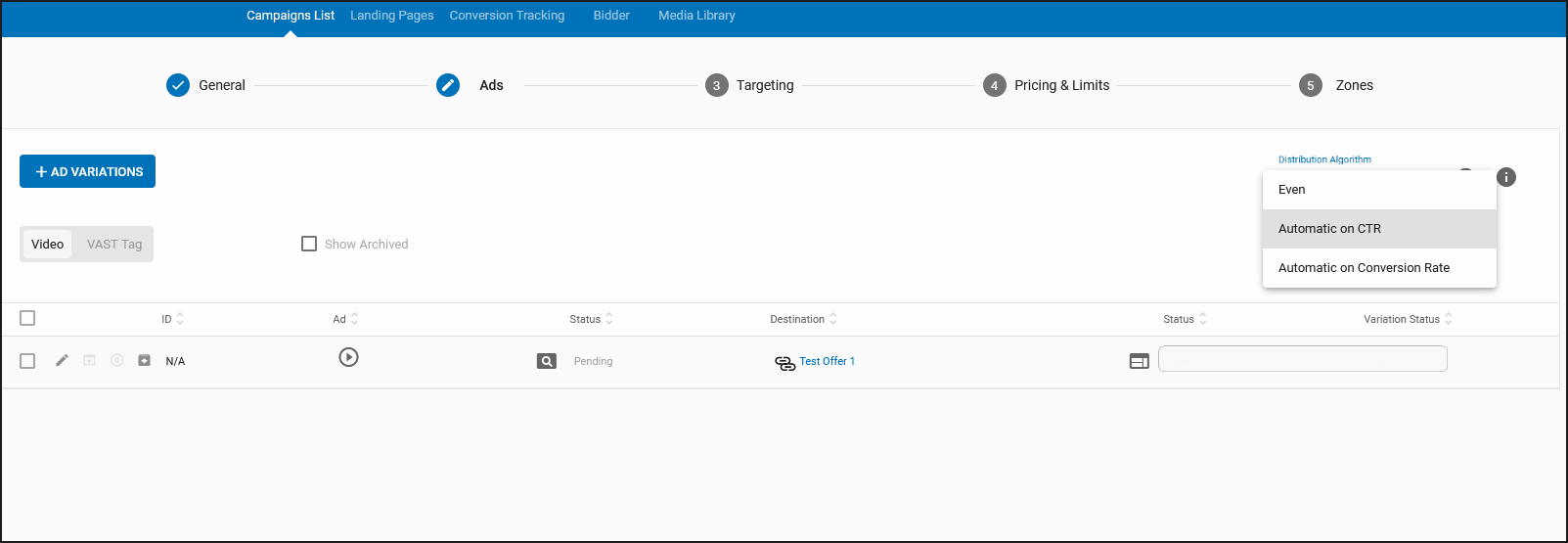
Step 4: Targeting – Here you can target or exclude in the campaign by Location, Devices, Operating Systems, Languages, Browsers and Mobile Carriers, etc.
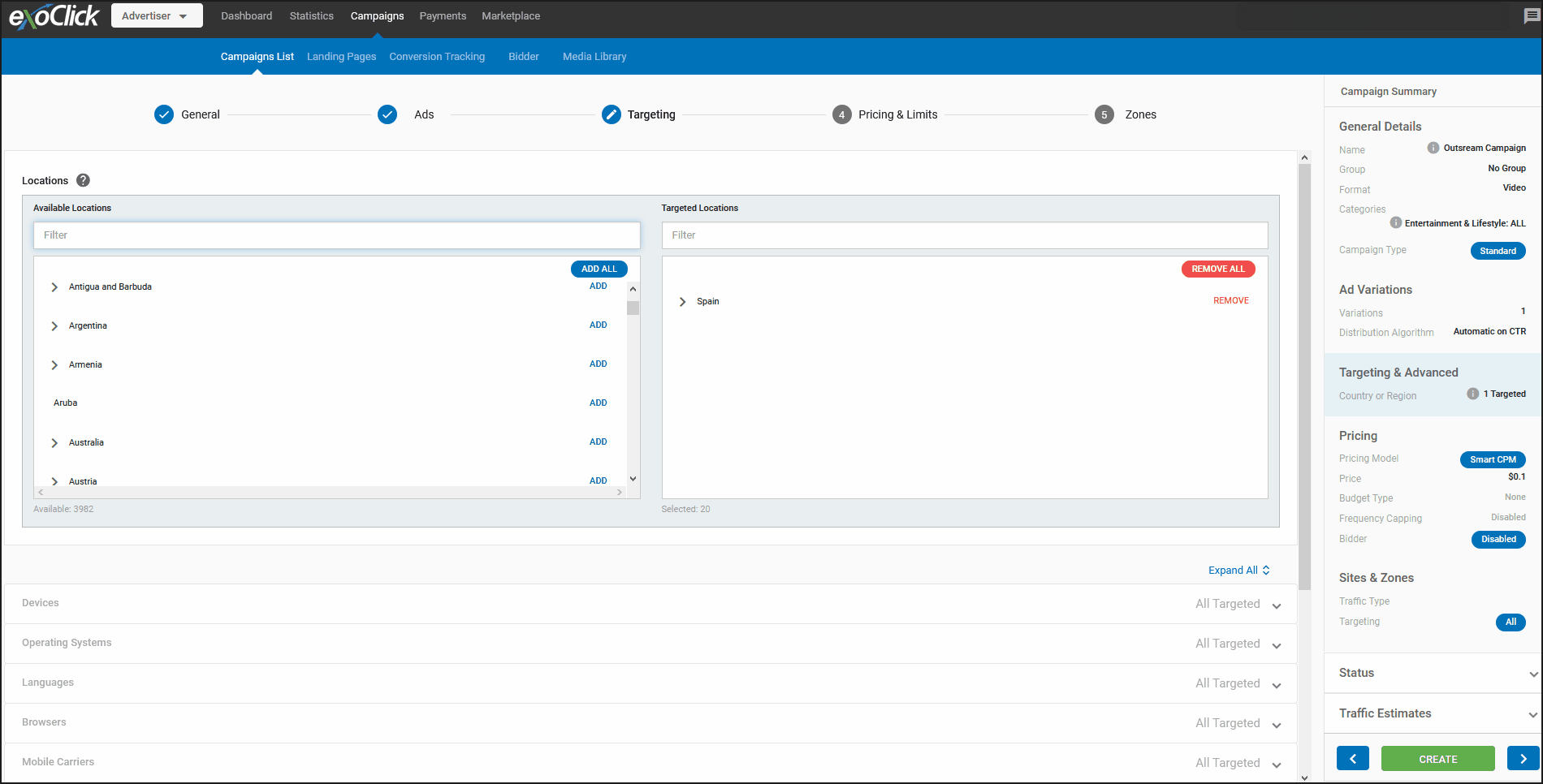
Step 5: Pricing & Limits
- In the Pricing & Limits tab, you choose the Pricing model used (Smart CPM, CPM, CPC, or CPV) and Frequency Capping for the campaign.
- You can establish Limits (Daily or Total) in your campaign or set a set Time Period for the campaign to run using the Start Date and End Date.
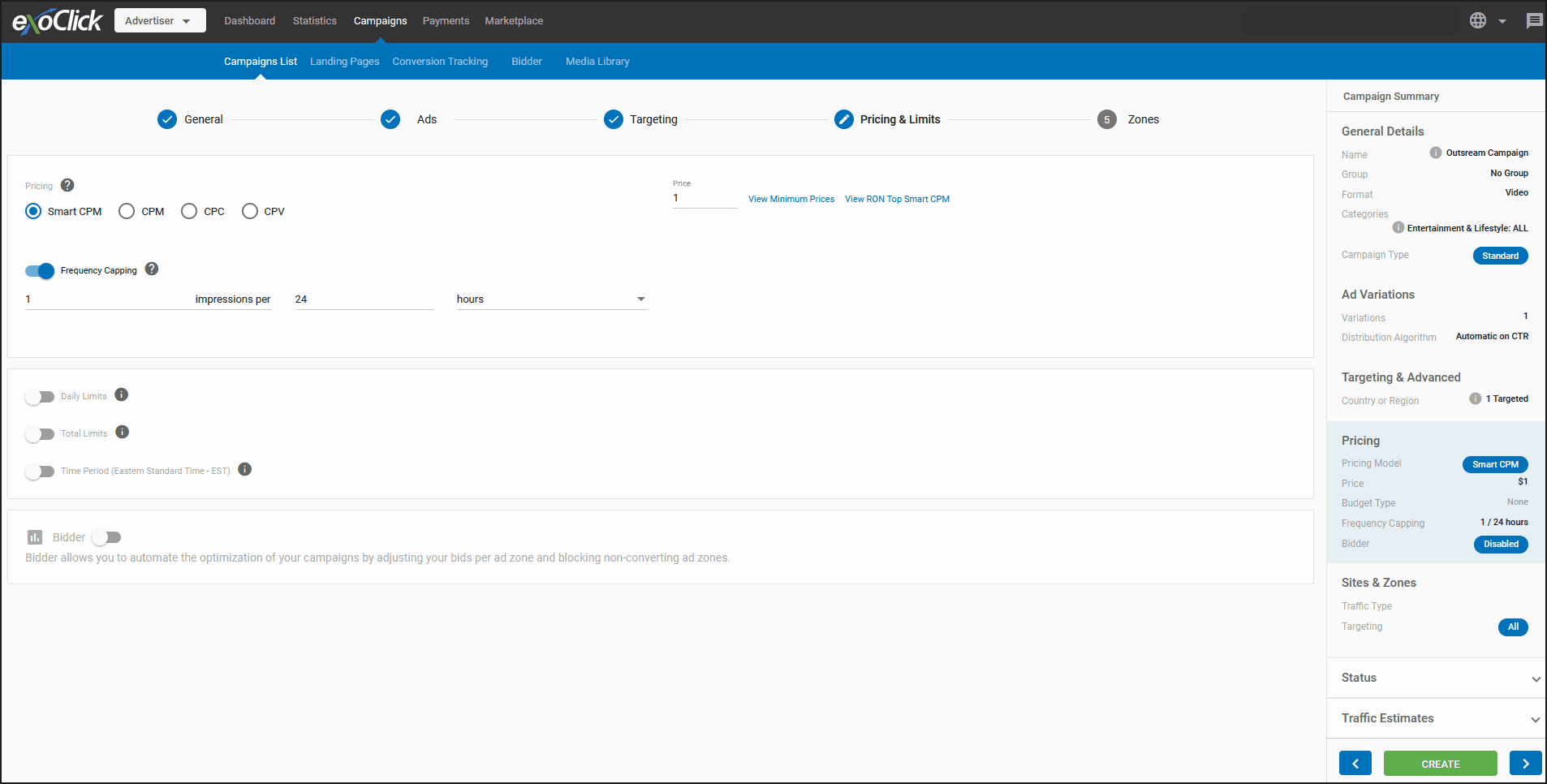
Step 6: Zones – Here you can choose which sites and zones to target and exclude.
